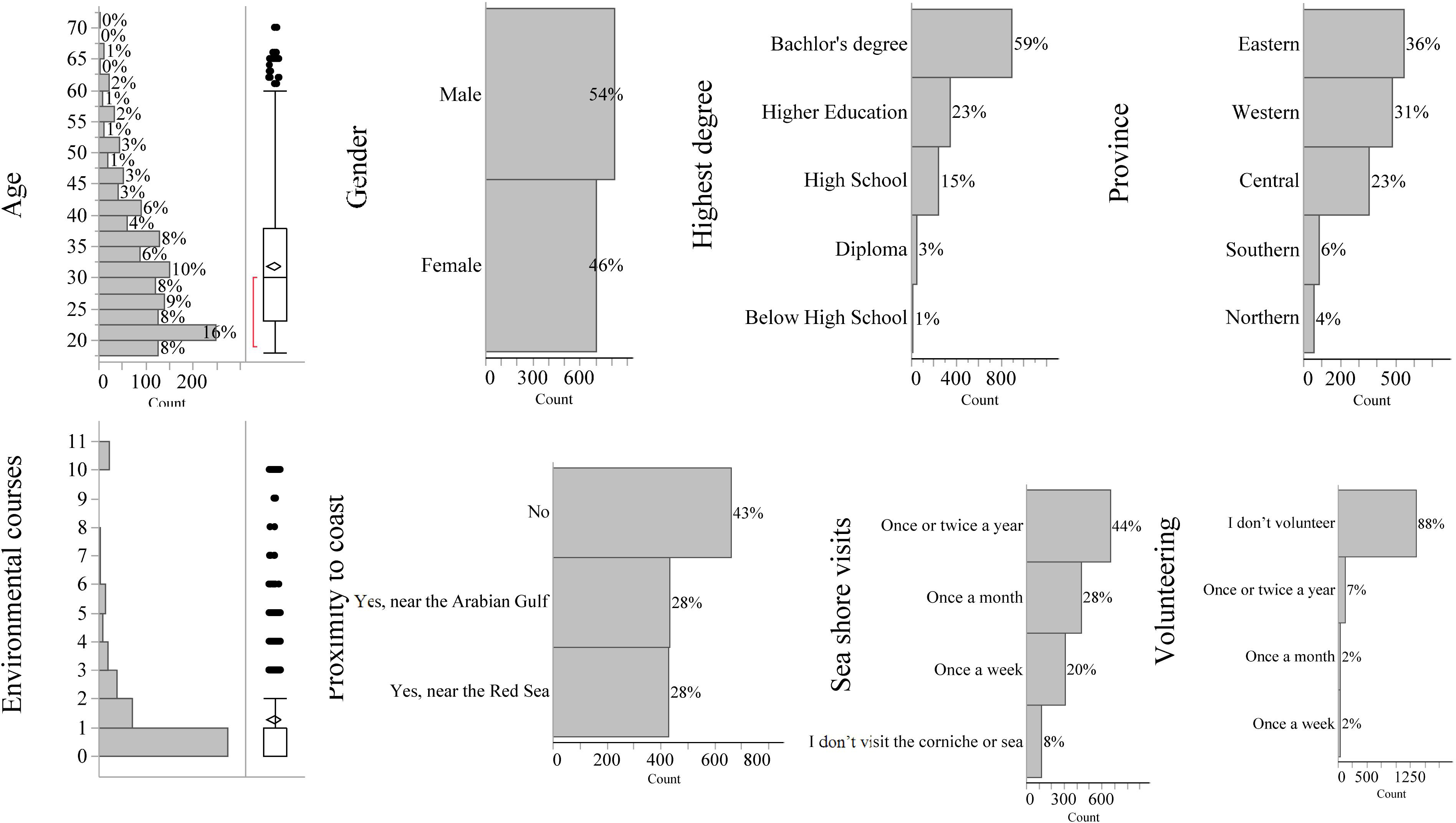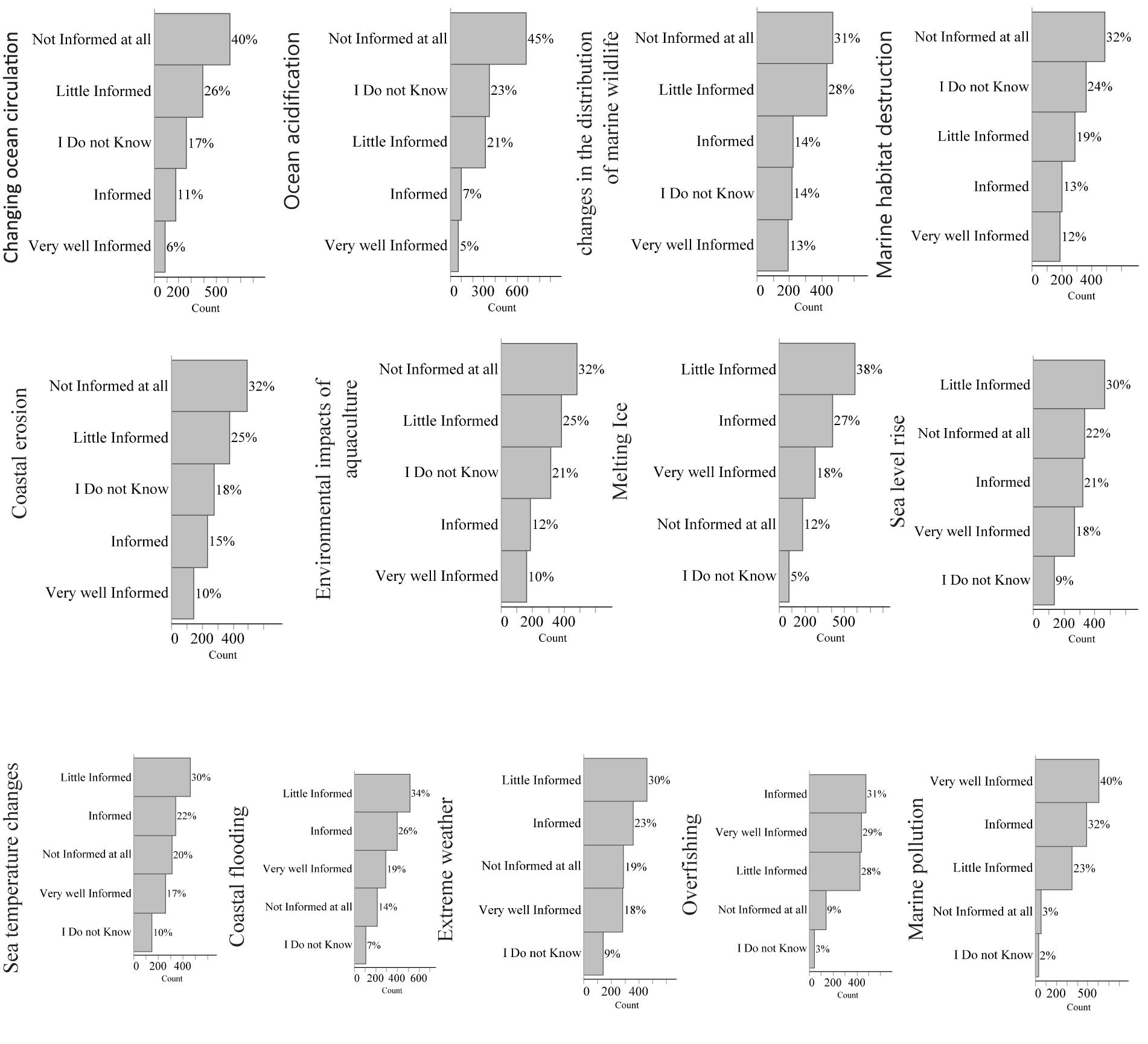- 1Department of Biology, College of Science, Imam Abdulrahman Bin Faisal University (IAU), Dammam, Saudi Arabia
- 2Red Sea Research Center and Computational Bioscience Research Center, King Abdullah University of Science and Technology, Thuwal, Saudi Arabia
We depend on the sea, economically, social well-being, and for the quality of our lives, yet direct and indirect human activities have affected the marine environment, causing many problems such as overfishing and pollution at the local scale and ocean warming and acidification at the global one. Hence, addressing the cumulative effects of these activities is required to conserve the marine environment for our current and future generations. Social commitment and support for these actions depend, however, on awareness and requires, therefore, an understanding of citizens’ awareness and perceptions on these issues. We assessed the awareness and the perceptions of Saudi citizens on ocean issues through an online questionnaire about environmental issues globally and in the country. The survey was completed by 1,524 Saudi citizens 18 years old and above, with different geographic distributions, gender, and educational status. The participants identified climate change within the top three global problems, with variable level of information and trust on different sources of environmental information. Littering, sewage pollution, and chemical pollution were identified as the top three major marine issues in Saudi Arabia, with the respondents demanding an immediate action through imposing fines to polluters and more regulatory constraints to activities that act as sources of pollution as well as supporting research in science and technologies to address these environmental issues.
Introduction
Environmental issues have become prevalent during the 20th century. Addressing these issues is central to achieving the 2015 UN sustainable development goals, which strive at reaching a new balance between economic development and environmental health (Assembly, 2015). The oceans stand out as a key component of the biosphere, called to accommodate much of the increasing demands for resources (food, water, and energy) required to meet future projected global human population growth (Duarte et al., 2009, 2020), yet marine ecosystems are under stress, affected by a number of problems including overfishing (Jackson et al., 2001), ocean acidification (Doney et al., 2009), climate change (IPCC, 2019), and pollution (Cózar et al., 2014), resulting in cumulative human pressures that compromise ocean health (Halpern et al., 2012; Duarte, 2014; Duarte et al., 2018). Addressing these problems require public awareness to bring ocean sustainability to the forefront of public debate and policy priorities. Indeed surveys of public attitudes toward problems affecting the ocean, such as climate change-related issues (e.g., sea level rise, warming), have been conducted in Europe (Potts et al., 2016; Buckley et al., 2017) and in the United States (Steel et al., 2005; Howe et al., 2015) but are lacking across much of the world so that our perceptions of public awareness and attitudes toward ocean sustainability challenges are often skewed toward specific western views.
The Kingdom of Saudi Arabia (KSA), flanked by the Red Sea and the Arabian Gulf, has one of the youngest populations in the world (General Authority for Statistics [GAS], 2018), but that has been relatively disconnected from the ocean, with the exception of fishing communities that represent a minor component of the current population, other than as a source of energy and transport of commodities.
However, in the Kingdom of Saudi Arabia (KSA), the ocean is gaining a prominent role in the nation’s ambitious Vision 2030 program1 aimed at transforming the economy and modernizing the nation (Daye, 2019). Three large development projects (NEOM, the Red Sea Project, and Amaala) are being specifically deployed along the shores of the Red Sea. Hence, understanding public awareness and perceptions of environmental issues affecting the marine environment and its capacity to support the nation’s sustainable development plans is important to guide policies.
The opinion polls of KSA citizens have rarely been published but are now being used to assess public perceptions of Vision 2030 programs. However, despite the central role of a sustainable ocean in these programs, we are not aware of surveys assessing the level of information, awareness, and concern on marine environmental issues by KSA citizens.
Here we report on the level of information, awareness, and concern on marine environmental issues by KSA citizens based on a survey including 1,524 respondents (18 years old or above) across the nation.
Materials and Methods
The survey, conducted in Arabic language (Supplementary Information S1 and S2), was designed as an online questionnaire on Google Forms2, which could be completed in about 20 min. The survey was open from October 2018 to January 2019 to KSA citizens 18 years old or above. The survey was sent online through social media (WhatsApp and Twitter) and by email to students in Saudi universities across the nation, which they then distributed around their networks. This questionnaire was adopted from a recent survey on public perceptions on marine climate change impacts conducted in Europe (Buckley et al., 2017) to allow for comparisons to be drawn. Metadata on the participants were collected, including their age, gender, educational status, province, proximity of their residence to the coast, and number of environmental courses they have taken, followed by questions aimed at gathering their opinions about which sea in the Kingdom of Saudi Arabia they consider is more polluted (the Red Sea or the Arabian Gulf), how many times they visit the coast or seaside boulevards, and their willingness to engage in volunteer cleanup activities. The number of environmental courses they took during their education was inferred by matching the degrees obtained and the Saudi official science curriculum taught to students from grade 1 to grade 12 in public schools (Table 1).
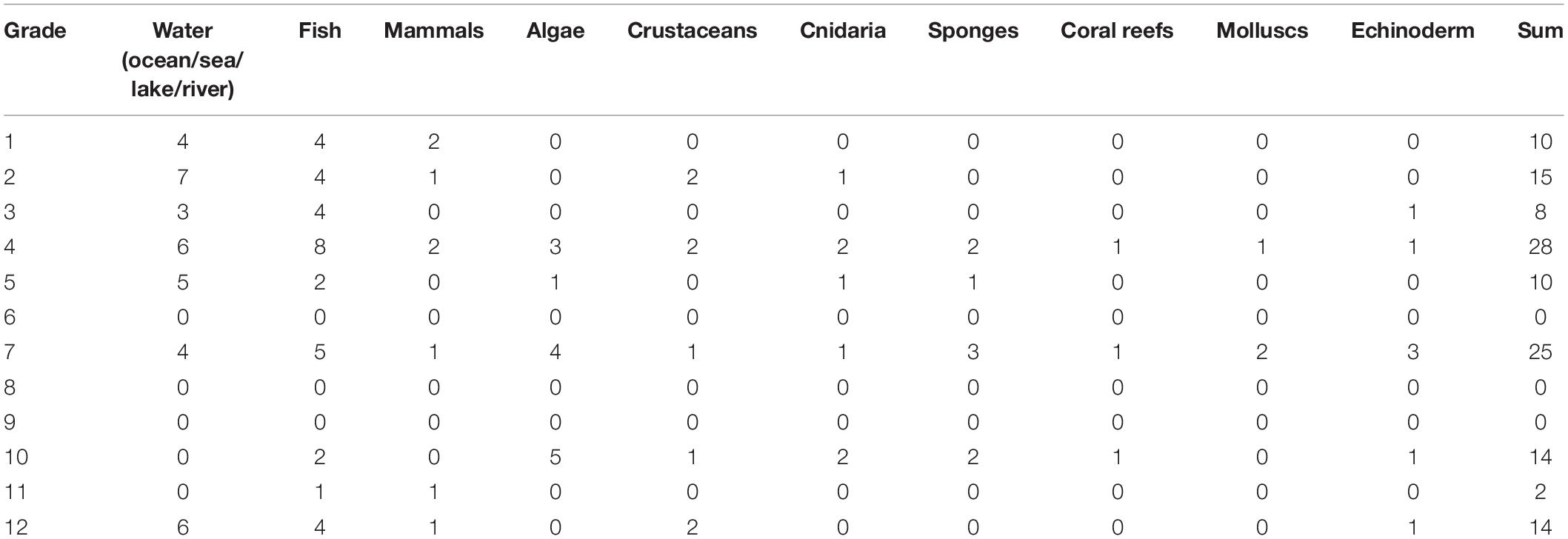
Table 1. Number of subjects related to marine environment in Saudi students’ books from grade 1 to grade 12.
We then asked the participants to identify three marine environmental issues in KSA and asked for their opinion as to whether these issues are caused by human or reflect natural processes. We also asked the participants to identify the most serious problem that the world as a whole is currently facing and tested their understanding of actual and projected global sea level rise and sea temperature. Then, we tested their level of awareness across a suite of marine issues, their level of trust on different sources of information regarding marine environmental issues, and how effective different organizations are in tackling marine issues. Finally, we asked the participants if they were engaged in actions to reduce and cope with the impacts of marine environmental issues and what marine policies should the government prioritize.
Descriptive statistics and general linear models were used to assess differences between age, gender, highest degree, number of environmental courses taken, and proximity to the coast versus marine issues. All statistics were computed using JMP v13.
Results
The survey was completed by 1,524 Saudi citizens with demographics (18 years old or above, the median being 30 years old), gender, educational status, and geographic distributions representative of national populations (Figure 1). However, the respondents had a higher education level as measured by the highest degree (81.2% of the respondents holding a higher education degree) than the expected average for a random sample of Saudi citizens in the same age class (18.8% in the age class >18 years holding a higher education degree; Table 2).
Whereas general education was high, the respondents acknowledged a weak exposure to environmental studies, as reflected in 60% of the respondents not having received any course specific on environmental studies during their education (Figure 1). A total of 43% of the respondents lived inland, leading to low exposure to the ocean, with a similar percent visiting the coast only once or twice per year (Figure 1), resulting in low levels of participation in coastal cleanup activities.
Perceptions of the most pressing issues worldwide included two issues related to environmental health (poverty, insufficient access to food and water, and climate change) within the top three global concerns, identified as the most important global problem by 46% of respondents, only preceded by war and conflicts (Figure 2). Most (85% of the respondents) of them identified environmental problems to be mainly or entirely caused by humans and considered the Red Sea to be more polluted than the Arabian Gulf (Figure 2).
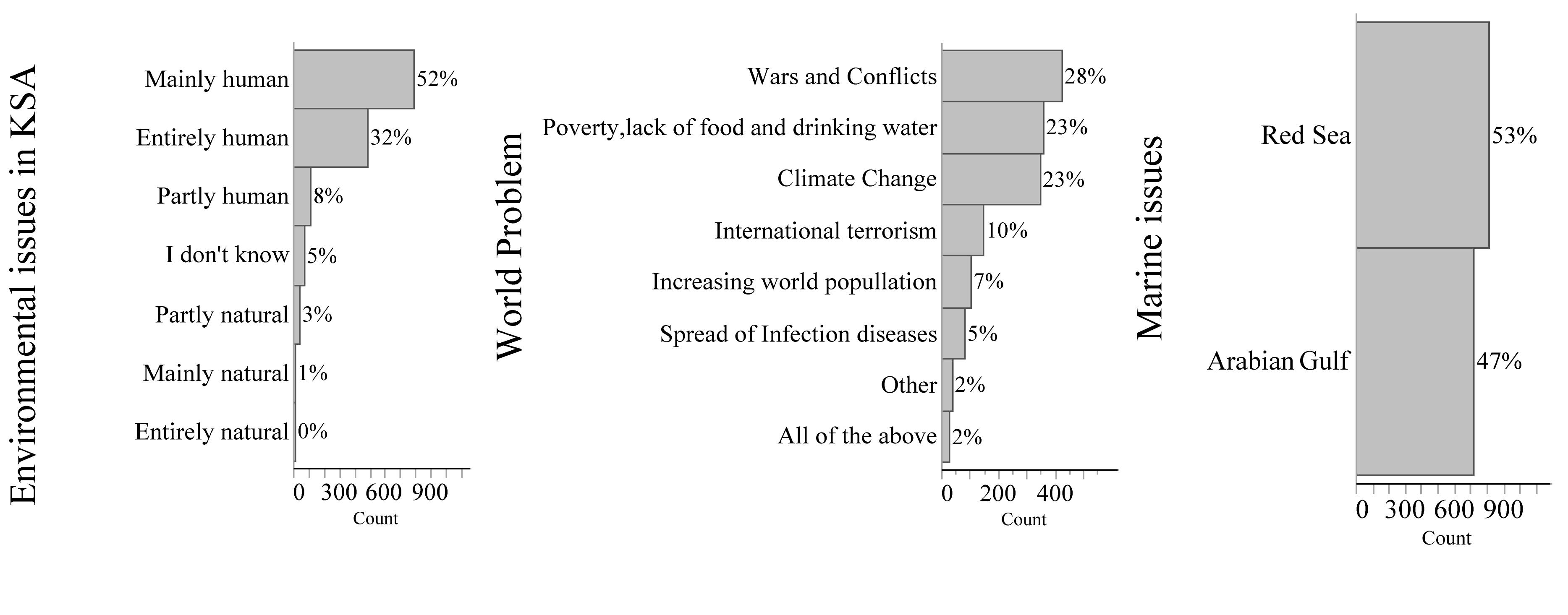
Figure 2. Responses to the questions: Thinking about the causes of marine environmental issues in Saudi Arabia, which, if any, of the following best describes your opinion? In your opinion, which of the following do you consider to be the most serious problem currently facing the world as a whole? Which sea do you think suffers of more coastal marine issues?
The modal awareness of a suite of marine issues revealed that most respondents felt uninformed of changes in ocean circulation, ocean acidification, shifts in distribution of marine species with climate change, as well as marine habitat loss (e.g., mangrove forests), coastal erosion, and environmental impacts of aquaculture (Figure 3). However, the modal responses showed that the respondents felt somewhat informed of melting ice, sea level rise, ocean warming, coastal flooding, marine extremes, and storms, all related to climate change impacts (Figure 3). The modal responses showed that the respondents felt informed of overfishing as a significant problem and very well informed on marine pollution issues (Figure 3). Furthermore, when testing how awareness of marine issues varied with respondent traits (age, gender, highest degree, number of environmental courses taken, and proximity to the coast), we found that environmental education, as reflected in the number of environmental courses taken, was the strongest (p < 0.0001) (Supplementary Table S3). Among all of these issues, only awareness of the destruction of marine habitats and ocean warming increased with proximity to the coast (p < 0.0001, Supplementary Table S3).
When asked on the rates of change, 39% of the respondents’ modal responses involved asserting that global sea level rise will increase by 10 cm to 1 m, and 45% of the respondents believed that sea temperature will rise by <0.5°C up to 10°C over the next 100 years (Figure 4).
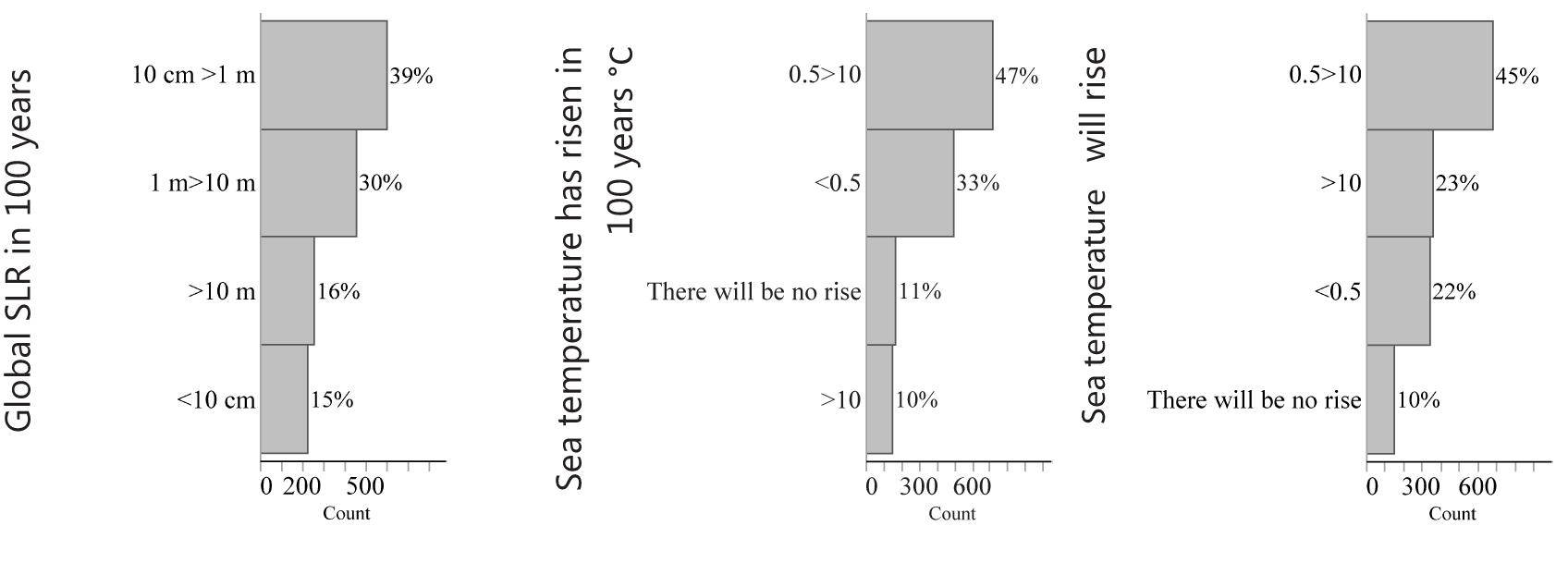
Figure 4. Responses to the questions: What do you think the global average sea level rise is likely to be, if at all, over the next 100 years? By how much do you think will the sea temperature around the coasts rise?
Moreover, the modal responses identified reports by government and environmental organizations as the most trusted sources of information in marine issues, selected by 52 and 73% of the respondents, respectively (Figure 5A), compared to little trust on newspapers (i.e., magazines, newspapers), books and scientific publications, web pages, social media, TV or radio as well as friends, family, or work colleagues (Figure 5A). The level of trust on newspapers, magazines, books, and scientific papers increased with increasing level of education of the respondents (p < 0.0001, Supplementary Table S3).
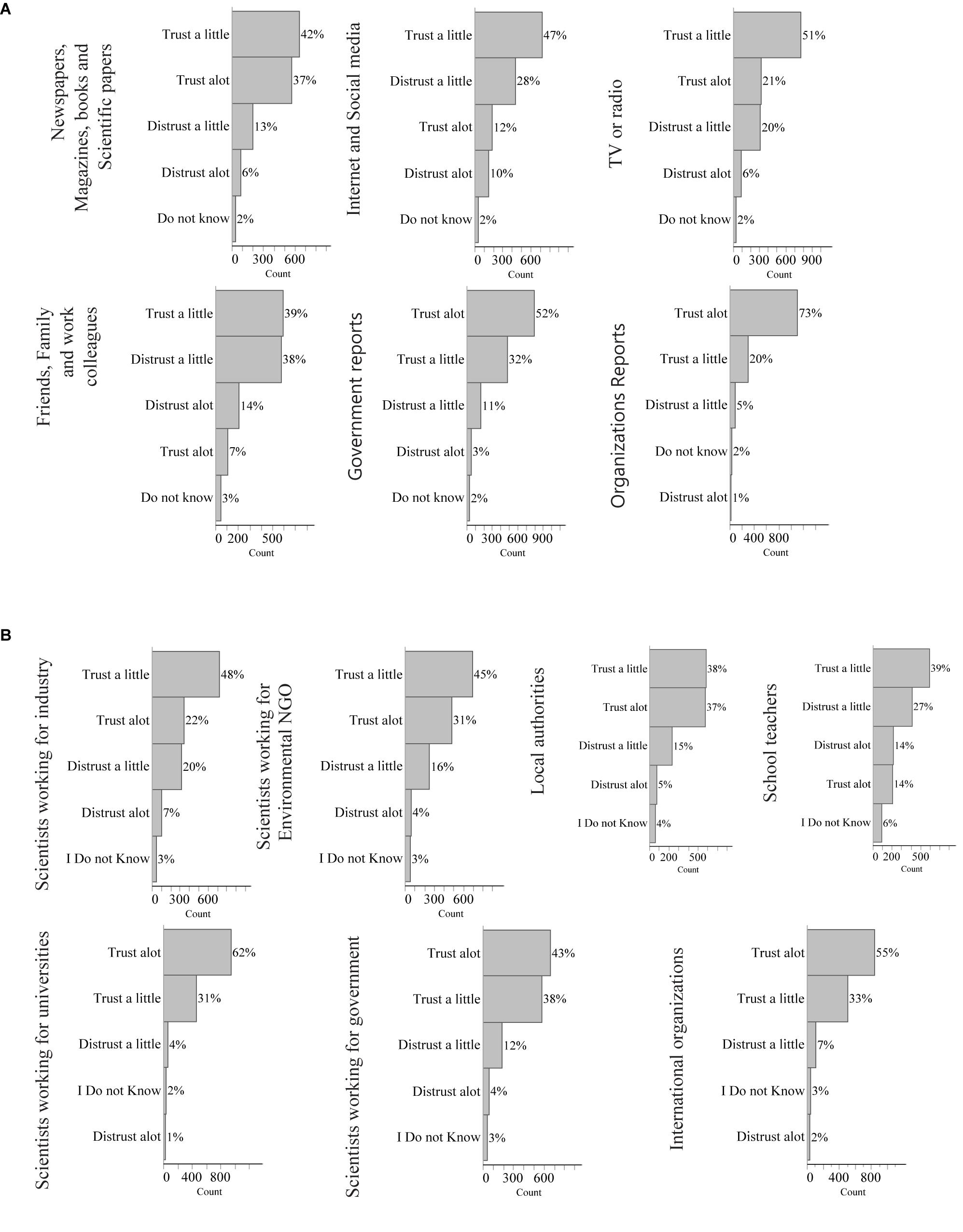
Figure 5. (A) Responses to the question: To what extent, if at all, do you trust each of the following types of media when providing information about coastal environmental issues? (B) Responses to the question: To what extent, if at all, do you trust each of the following individuals or organizations when providing information about coastal environmental issues?
When assessed on the trust on different professionals, the respondents deposited the highest trust on scientists working in universities and those working in governmental institutions and international organizations (62, 43, and 55% of respondents, respectively) compared to limited trust on scientists working in industry, NGOs, as well as professionals working in local government or schools (Figure 5B). The trust on scientists working in NGOs, universities, and international organizations increased with the level of education of the respondents, while the female respondents had more trust than the male respondents on scientists working in industry and governments, and older respondents had more trust on school teachers (p < 0.0001, Supplementary Table S3).
The respondents felt that businesses and industries are not effective in tackling coastal environmental issues, while the government, communities, international organizations, and volunteers are somewhat effective at addressing these issues (Figure 6). When asked on their own engagement in addressing these issues, 73% reduced their energy consumption, 72% of the participants had contributed to raising awareness by discussing these issues with family and friends or via social media. Moreover, 55% have used less quantities of wood while camping as firewood from nature, e.g., desertic or coastal wood plants, could increase environmental impacts; about half of the respondents chose environmentally friendly products (Figure 7), but very few respondents used environmentally friendly transportation, wrote about environmental issues, or consumed renewable energy or local food products (Figure 7). Furthermore, when examining how these actions varied across the respondents traits, we again found that the likelihood of using environmentally friendly transportation and contribute to raise awareness among Saudi citizens increased with the number of environmental courses taken (p < 0.0001), while young citizens were more likely to purchase locally produced food (Supplementary Table S3).
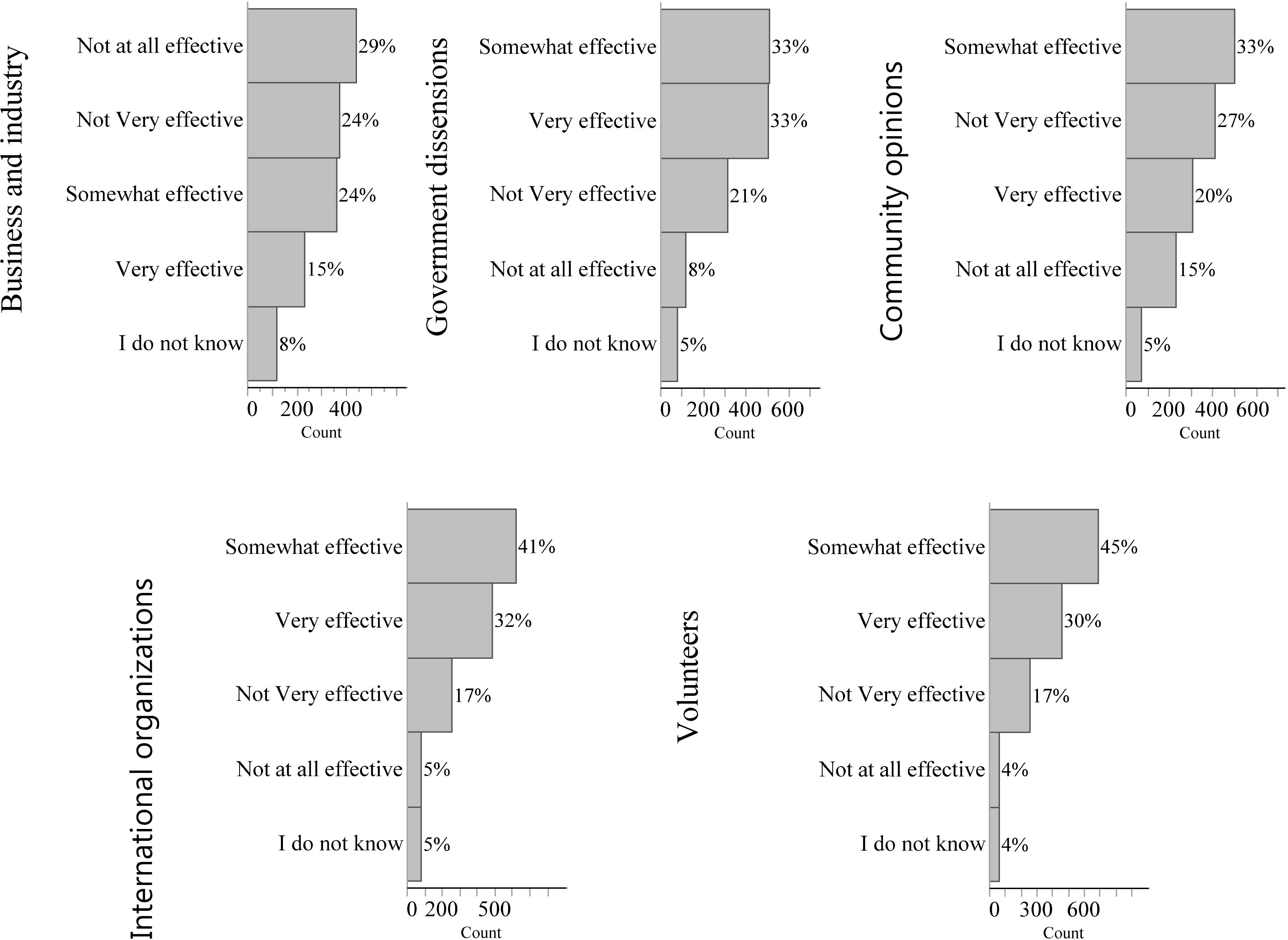
Figure 6. Responses to the question: How effective are the following in tackling coastal environmental issues at the coastline or in the sea?
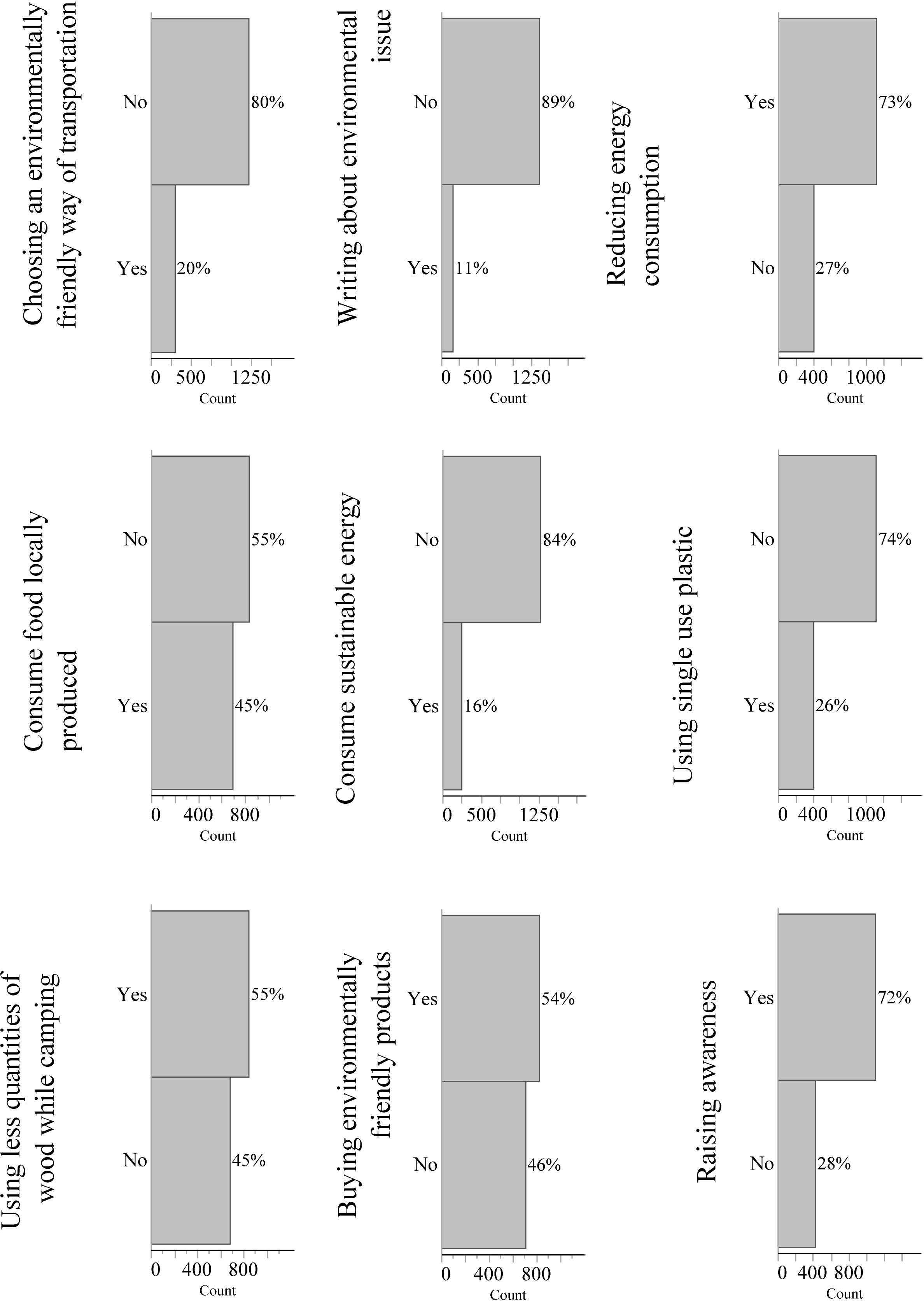
Figure 7. Responses to the question: Please indicate whether you have taken any of the following actions to reduce and cope with the impacts of marine environmental issues.
When ask to freely elaborate on what were the most important marine environmental issues in Saudi Arabia, the respondents identified marine litter and chemical and sewage pollution as the top three major marine issues in the nation (Figure 8). A majority (76%) considered that economic punitive actions (e.g., fines) should be prioritized by Saudi government to address environmental issues, and similar proportions of respondents considered that greater oversight over commercial activities in the marine environment (44% of respondents) and enhanced scientific research efforts (43%) are required to address environmental marine impacts (Figure 9).
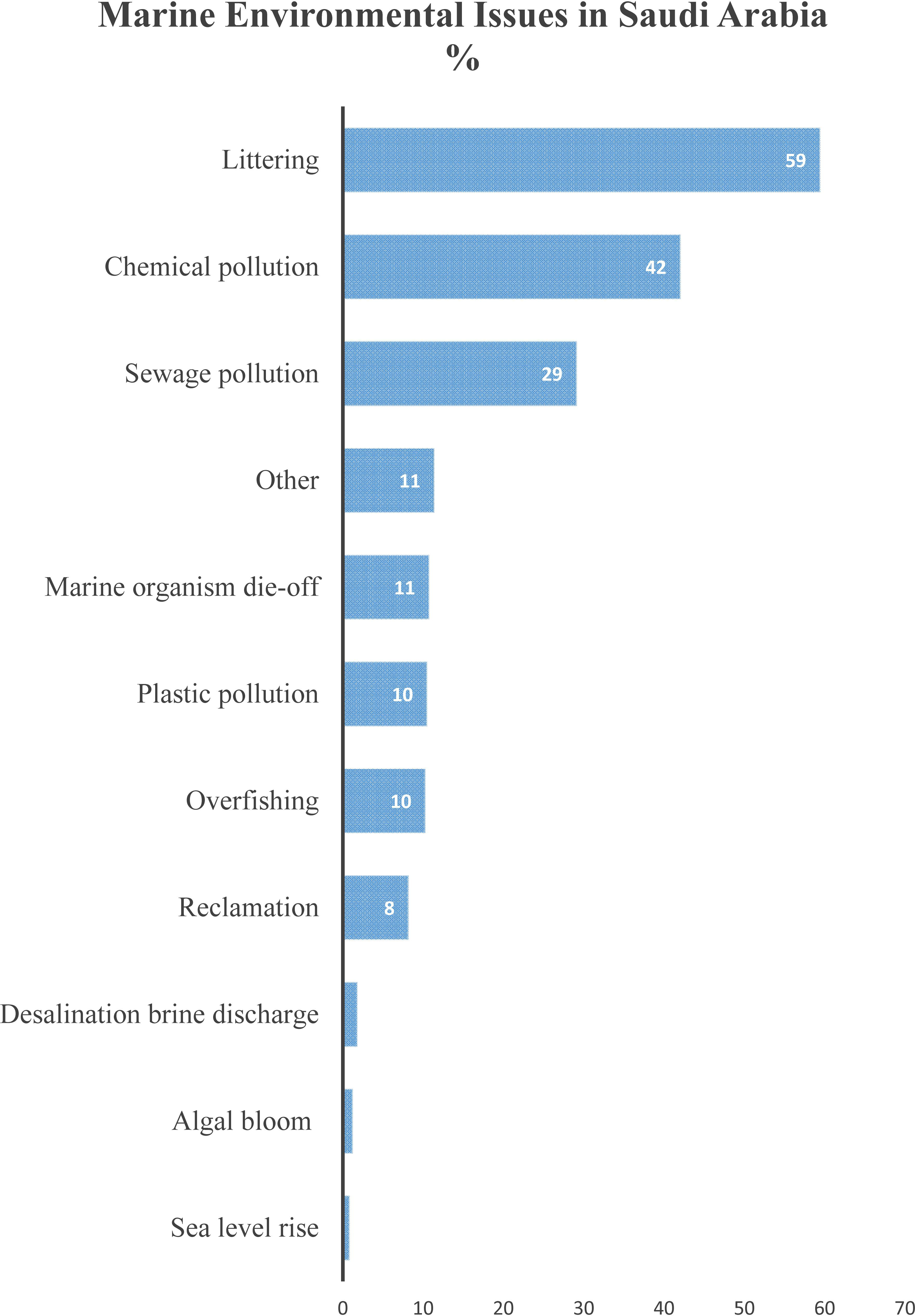
Figure 8. Responses to the question: When you think about the coastline or the sea, what are the three most important marine environmental issues that come to mind in Saudi Arabia?
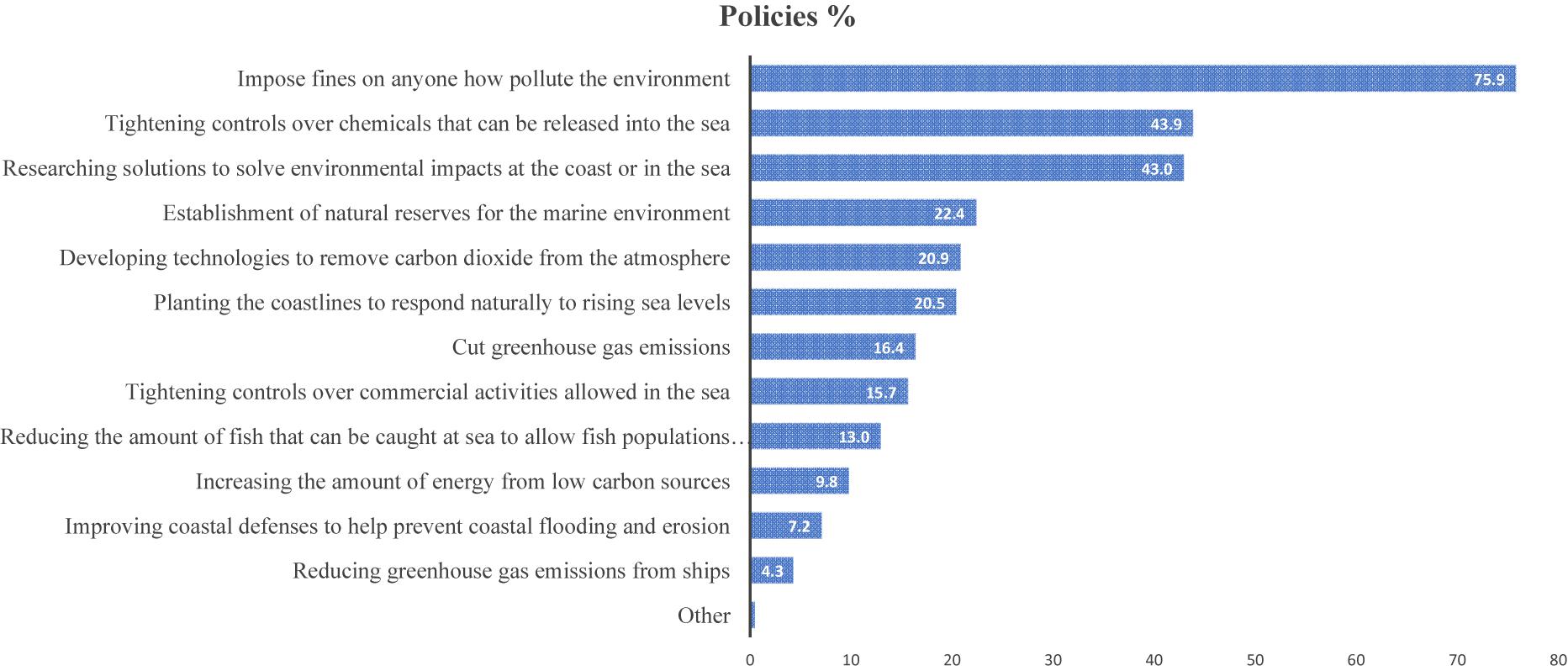
Figure 9. Responses to the question: If you had to decide what marine policies should be prioritized by the government, which three would you select from the list below?
The greater representation of respondents holding a higher education degree relative to those expected from a random sample of Saudi population (81.2% of respondents vs. 18.8% of the Saudi population older than 18 years) may have biased the overall results from our survey. We therefore assessed, by subsampling the responses received, how and whether this bias could affect our results. To do so, we randomly subsampled a subset of the respondents holding higher education degrees (Table 2), corresponding to that expected by change on a random survey with 100% response rate, and recalculated all response metrics. In general, the results did not change (Supplementary Table S4); the impact of the bias in the level of education was generally reflected in 1 or 2% difference in the responses, with no change in the order of trust and information. The ANOVA assessing between age, gender, courses, and proximity to coast showed, however, some differences, which are presented and discussed. We specifically found that the importance of environmental education, as reflected in the number of environmental courses taken, was reduced to match the proximity of the residence to the coast in its contribution to explain the variability in perceptions among respondents (p < 0.01) (Supplementary Table S5). Also, gender differences in trust on newspapers, magazines, books, and scientific papers as well as trust on scientists working in international organizations and reports by organizations were somewhat reduced (p < 0.01, Supplementary Table S5).
Discussion
The respondents had a higher education level, as measured by the highest degree (81.2% of respondents holding a bachelor degree), than the average of the population (18.8% in the age class >18 years). In 2015, the median age of Saudi Arabia’s population was 30 years (Plcher, 2019), which corresponds to about 58% of citizens below 30 years old who participated in this study (see Supplementary Material S6) according to the Saudi General Authority for Statistics (General Authority for Statistics [GAS], 2018). However, 81.2% of the respondents held a higher education degree compared with 18.8% in the age class >18 years holding a higher education degree (see Supplementary Material S7) according to the Saudi (General Authority for Statistics [GAS], 2017a, b).
About one in every four (23%) Saudi citizens identified climate change as the most serious problem that the world is facing, 5% higher than European citizens who survived in 2011 (Buckley et al., 2017). A vast majority, 85% of Saudi citizens, identified environmental problems to be mainly or entirely caused by humans. This is consistent with the conclusions of the Fifth Assessment Report of the Intergovernmental Panel on Climate Change (IPCC) released in 2014, stating that: “Human influence has been detected in warming of the atmosphere and the ocean, in changes in the global water cycle, in reductions in snow and ice, and in global mean sea level rise; and it is extremely likely to have been the dominant cause of the observed warming since the mid-20th century” (Pachauri et al., 2014). However, the large prevalence of Saudi citizens identifying humans as largely responsible for climate change far exceeded that of European citizens, where only 46% believed that climate change is either “mainly” or “entirely” caused by human activity (Buckley et al., 2017).
Half (43%) of the respondents live inland and have both a low exposure to the ocean and a low frequency of visits to the shore; for further information on the total population distribution in the kingdom, see the distribution map by the Saudi General Authority for Statistics3. This affected their direct understanding of the marine environment and was reflected in insufficient awareness of the extent of destruction of marine habitats and ocean warming (Figure 3). Brody et al. (2008) found that awareness of climate change was significantly lower for United States respondents located far away from the coast, while Potts et al. (2016) did not find a relation between awareness of marine environment or climate change and distance to the coast. Nevertheless, the Saudi responders felt somewhat informed of climate change effects (i.e., melting ice, sea level rise, ocean warming, coastal flooding, marine extremes, and storms) and declared to be well informed on overfishing and marine pollution regardless of exposure to the coast.
The level of environmental education of the respondents was the most important trait affecting their general understanding of marine issues. Indeed the respondents showed an overall weak environmental knowledge, which reflects the low attention to environmental issues currently included in the Saudi official science curriculum, with 126 subjects on environmental issues from grade 1 to grade 12 (Table 1, data of these subjects were gathered in 2018, Supplementary Material S8). Our results provide evidence that the higher return rate of respondents with higher education degrees than expected by change introduced the bias, albeit mild. Respondent bias, involving a higher likelihood of responses from individuals with high availability and interest, has been identified as a major, unavoidable source of bias in surveys, including large-scale national surveys (Heffetz and Reeves, 2019). An approach to assess respondent bias includes assessing the demographic profile of the respondents relative to that expected under a random response rate, as was done here. This exercise showed that the assessment was robust against the mild bias introduced by the high proportion of respondents holding a higher education degree.
Moreover, 39% of the respondents believe that global sea level rise will increase by 10 cm to >1 m, and 47% of the respondents think that the sea temperature has risen by 10 < 0.5°C with a similar percent and range in the next 100 years (Figure 4). In fact, climate change has doubled the sea level rise globally; the rate of global averaged sea level rise was 1.7 (1.5–1.9) mm yr–1 between 1901 and 2010, 2.0 (1.7–2.3) mm yr–1 between 1971 and 2010, and 3.2 (2.8–3.6) mm yr–1 between 1993 and 2010 (Stocker et al., 2013), whereas the globally averaged combined land and ocean surface temperature data, as calculated by a linear trend, show a warming of 0.85°C (0.65–1.06°C) over the period 1880–2012, when multiple independently produced datasets exist. The total increase between the average of the 1850–1900 period and the 2003–2012 period is 0.78°C (0.72–0.85°C) (Stocker et al., 2013).
The media had an overall major influence in public opinions, as reported for Japan (Sampei and Aoyagi-Usui, 2009), United Kingdom (Boykoff and Mansfield, 2008; Shaw, 2013), Australia (Farbotko, 2005), and the United States (Boykoff and Boykoff, 2007). Saudi citizens mostly trust information on environmental issues that derive from governmental reports and environmental organization reports. This is in contrast to little trust on newspapers, magazines, books and scientific papers, social media, TV, or radio as well as information derived from social interactions with friends, family, or work colleagues. Saudi citizens attach high trust to scientists working for universities and scientists working for government and international organizations compared with their limited trust on industry scientists, NGOs, and local authorities or school teachers. Assessments in Europe showed that their citizens had a similarly low level of trust for scientists working for government and industry compared to university scientists and NGOs (Buckley et al., 2017).
Conclusion
Saudi citizens identified littering, sewage pollution, and chemical pollution as the top three major marine issues in the country and support the strongest enforcement of the government through fines and better oversight of commercial activities at sea. Our results also point to the high level of support for government to implement solutions to marine environmental issues, including climate change impact, supported by the research of scientists working for universities and government and international organizations, which they strongly and majorly trust. Improving the attention to environment in the Saudi education curriculum emerged as an easily achievable strategy to promote awareness and positive citizen-based action in addressing marine environmental issues.
Data Availability Statement
All datasets generated for this study are included in the article/Supplementary Material.
Author Contributions
HA and CD designed the study, did the statistical analysis, and wrote the manuscript. Both authors contributed to the article and approved the submitted version.
Conflict of Interest
The authors declare that the research was conducted in the absence of any commercial or financial relationships that could be construed as a potential conflict of interest.
Acknowledgments
We thank the participants in the survey for taking some of their time to answer this questionnaire and Imam Abdulrahman Bin Faisal University (IAU) for helping in distributing this questionnaire to in-kingdom universities. We are also thankful to three intern students, Alanoud Alyami, Atheer Alghamdi, and Lama Aldossary.
Supplementary Material
The Supplementary Material for this article can be found online at: https://www.frontiersin.org/articles/10.3389/fmars.2020.00600/full#supplementary-material
Footnotes
- ^ https://vision2030.gov.sa/en
- ^ https://www.google.com/forms/about/
- ^ https://www.stats.gov.sa/sites/default/files/en-dmaps2010_0_0.pdf
References
Assembly, G. (2015). Transforming Our World: The 2030 Agenda for Sustainable Development. Available online at: https://sustainabledevelopment.un.org/post2015/transformingourworld
Boykoff, M. T., and Boykoff, J. M. (2007). Climate change and journalistic norms: a case-study of US mass-media coverage. Geoforum 38, 1190–1204. doi: 10.1016/j.geoforum.2007.01.008
Boykoff, M. T., and Mansfield, M. (2008). ‘Ye Olde Hot Aire’∗: reporting on human contributions to climate change in the UK tabloid press. Environ. Res. Lett. 3:024002. doi: 10.1088/1748-9326/3/2/024002
Brody, S. D., Zahran, S., Vedlitz, A., and Grover, H. (2008). Examining the relationship between physical vulnerability and public perceptions of global climate change in the United States. Environ. Behav. 40, 72–95. doi: 10.1177/0013916506298800
Buckley, P. J., Pinnegar, J. K., Painting, S. J., Terry, G., Chilvers, J., Lorenzoni, I., et al. (2017). Ten thousand voices on marine climate change in Europe: different perceptions among demographic groups and nationalities. Front. Mar. Sci. 4:206. doi: 10.3389/fmars.2017.00206
Cózar, A., Echevarría, F., González-Gordillo, J. I., Irigoien, X., Úbeda, B., Hernández-León, S., et al. (2014). Plastic debris in the open ocean. Proc. Natl. Acad. Sci. U.S.A. 111, 10239–10244.
Daye, A. S. (2019). Rising tourism in Saudi Arabia: implications for real estate investment. Cornell Real Estate Rev. 17:22.
Doney, S. C., Fabry, V. J., Feely, R. A., and Kleypas, J. A. (2009). Ocean acidification: the other CO2 problem. Annu. Rev. Mar. Sci. 1, 169–192.
Duarte, C. M. (2014). Global change and the future ocean: a grand challenge for marine sciences. Front. Mar. Sci. 1:63. doi: 10.3389/fmars.2014.00063
Duarte, C. M., Agusti, S., Barbier, E., Britten, G. L., Castilla, J. C., Gattuso, J.-P., et al. (2020). Rebuilding marine life. Nature 580, 39–51. doi: 10.1038/s41586-020-2146-7
Duarte, C. M., Gunn, J., and Poiner, I. (2018). Perspectives on a global observing system to assess ocean health. Front. Mar. Sci. 5:265. doi: 10.3389/fmars.2018.00265
Duarte, C. M., Holmer, M., Olsen, Y., Soto, D., Marbà, N., Guiu, J., et al. (2009). Will the oceans help feed humanity? BioScience 59, 967–976. doi: 10.1525/bio.2009.59.11.8
Farbotko, C. (2005). Tuvalu and climate change: constructions of environmental displacement in the Sydney Morning Herald. Geografiska Annaler Ser. B Hum. Geogr. 87, 279–293. doi: 10.1111/j.0435-3684.2005.00199.x
General Authority for Statistics [GAS] (2017a). Population Characteristics Survey 2017. Riyadh: General Authority for Statistics.
General Authority for Statistics [GAS] (2017b). Saudi Population by Age Groups and Educational Status, Source: Education and Training Survey 2017. Riyadh: General Authority for Statistics.
General Authority for Statistics [GAS] (2018). Population by Gender, Age Groups and Nationality (Saudi/Non-Saudi). Riyadh: General Authority for Statistics.
Halpern, B. S., Longo, C., Hardy, D., McLeod, K. L., Samhouri, J. F., Katona, S. K., et al. (2012). An index to assess the health and benefits of the global ocean. Nature 488:615.
Heffetz, O., and Reeves, D. B. (2019). Difficulty of reaching respondents and nonresponse bias: evidence from large government surveys. Rev. Econ. Stat. 101, 176–191. doi: 10.1162/rest_a_00748
Howe, P. D., Mildenberger, M., Marlon, J. R., and Leiserowitz, A. (2015). Geographic variation in opinions on climate change at state and local scales in the USA. Nat. Clim. Change 5:596. doi: 10.1038/nclimate2583
IPCC (2019). “Summary for policymakers,” in IPCC Special Report on the Ocean and Cryosphere in a Changing Climate, eds H.-O. Pörtner, D. C. Roberts, V. Masson-Delmotte, P. Zhai, M. Tignor, E. Poloczanska, et al. (Geneva: IPCC).
Jackson, J. B., Kirby, M. X., Berger, W. H., Bjorndal, K. A., Botsford, L. W., Bourque, B. J., et al. (2001). Historical overfishing and the recent collapse of coastal ecosystems. Science 293, 629–637. doi: 10.1126/science.1059199
Pachauri, R. K., Allen, M. R., Barros, V. R., Broome, J., Cramer, W., Christ, R., et al. (2014). “Climate change 2014: synthesis report,” in Proceedings of the Contribution of Working Groups I. II and III to the Fifth Assessment Report of the Intergovernmental Panel on Climate Change, (Geneva: IPCC).
Potts, T., Pita, C., O’Higgins, T., and Mee, L. (2016). Who cares? European attitudes towards marine and coastal environments. Mar. Policy 72, 59–66. doi: 10.1016/j.marpol.2016.06.012
Sampei, Y., and Aoyagi-Usui, M. (2009). Mass-media coverage, its influence on public awareness of climate-change issues, and implications for Japan’s national campaign to reduce greenhouse gas emissions. Glob. Environ. Change 19, 203–212. doi: 10.1016/j.gloenvcha.2008.10.005
Shaw, C. (2013). Choosing a dangerous limit for climate change: public representations of the decision making process. Glob. Environ. Change 23, 563–571. doi: 10.1016/j.gloenvcha.2012.12.012
Steel, B. S., Smith, C., Opsommer, L., Curiel, S., and Warner-Steel, R. (2005). Public ocean literacy in the United States. Ocean Coast. Manag. 48, 97–114. doi: 10.1016/j.ocecoaman.2005.01.002
Keywords: pollution, environment, questionnaire, climate change, citizens
Citation: Almahasheer H and Duarte CM (2020) Perceptions of Marine Environmental Issues by Saudi Citizens. Front. Mar. Sci. 7:600. doi: 10.3389/fmars.2020.00600
Received: 17 February 2020; Accepted: 29 June 2020;
Published: 27 August 2020.
Edited by:
Michelle Jillian Devlin, Centre for Environment, Fisheries and Aquaculture Science (CEFAS), United KingdomReviewed by:
Brett Phillip Lyons, Centre for Environment, Fisheries and Aquaculture Science (CEFAS), United KingdomJan Marcin Weslawski, Institute of Oceanology, Polish Academy of Sciences, Poland
Copyright © 2020 Almahasheer and Duarte. This is an open-access article distributed under the terms of the Creative Commons Attribution License (CC BY). The use, distribution or reproduction in other forums is permitted, provided the original author(s) and the copyright owner(s) are credited and that the original publication in this journal is cited, in accordance with accepted academic practice. No use, distribution or reproduction is permitted which does not comply with these terms.
*Correspondence: Hanan Almahasheer, aGFsbWFoYXNoZWVyQGlhdS5lZHUuc2E=
 Hanan Almahasheer
Hanan Almahasheer Carlos M. Duarte
Carlos M. Duarte